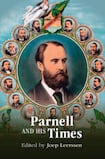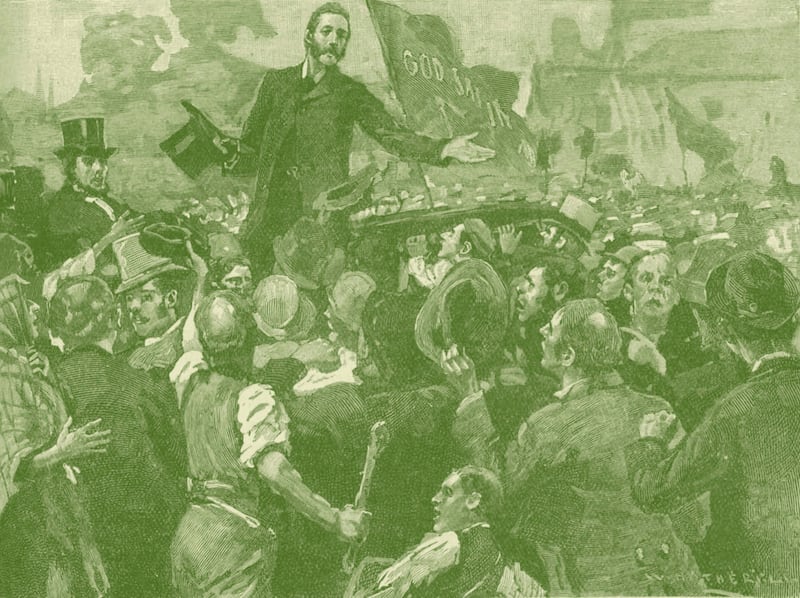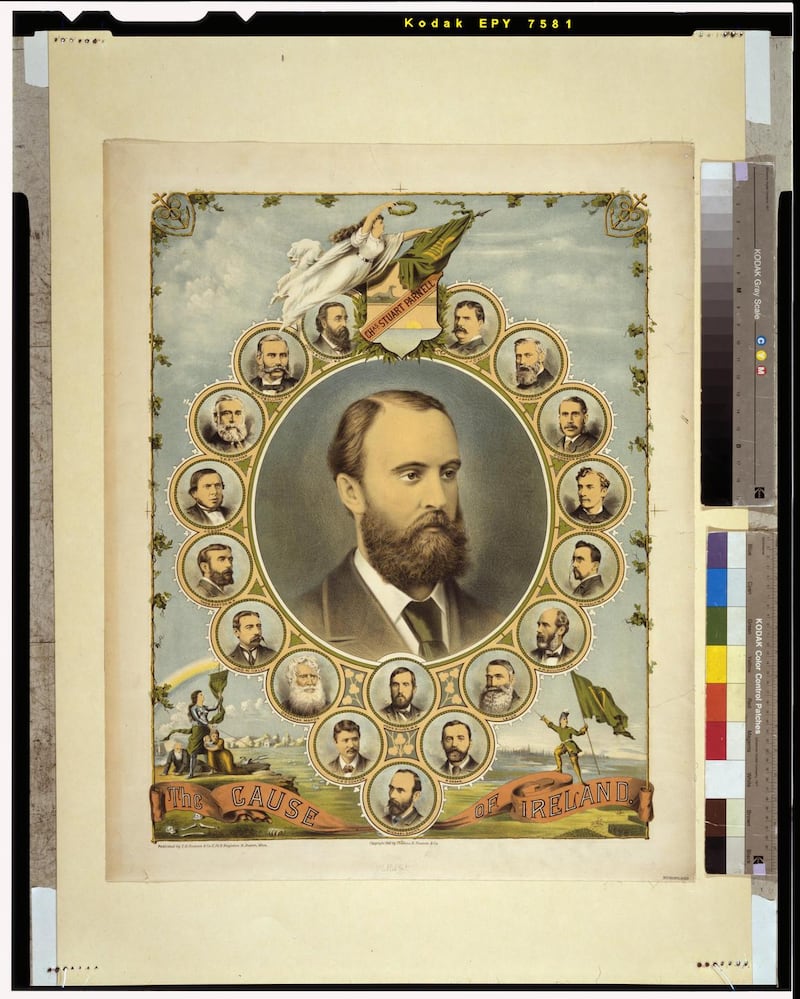
I am not quite convinced that the shadow of Charles Stewart Parnell covers quite as much as is suggested by Joep Leerssen, the editor of this sprawling volume, but he certainly cannot be accused of lacking the appetite to persuade the reader otherwise.
His melodramatic introductory essay robustly elaborates on the “the traumatic, undigested memory” of Parnell’s defeat and death in 1891 and the shadow it cast on Ireland’s transition to the 20th century because it “left Ireland with a Parnell-shaped hole in the middle, filled only partially by a Parnell myth”. Those nationalist politicians who came in his wake looked “puny in comparison . . . Parnell gone made it impossible to get over Parnell . . . almost like a big bang in reverse”. Steady on.
What binds the contributors is that they have all held the Parnell Fellowship at Magdalene College, Cambridge University, where Parnell studied. (His biographer FSL Lyons noted that the underwhelming Parnell found a place there as it was “lax in its admission standards” at a time when Parnell’s “academic defects were still legion”, not something mentioned here.) Given the range of the contributors’ interests this volume is mistitled and the chapters do not cohere; a better title would have been Parnell Fellows Expound Expansively.
That does not mean that there is not much to admire here; the scope of their expositions and the breadth of their scholarship is what you would expect from writers as accomplished as Roy Foster, Declan Kiberd, Clair Wills, David Fitzpatrick, Paul Bew, Frank McGuinness and Angela Bourke, among others. While the quality of the prose is impressive and sometimes employed with a light touch, overall the book smacks of an academic vanity project rather than a focused, coherent collection.

It is true that the death of Parnell seemed to leave a sense of hollowness, and a subsequent preoccupation with the notion of resurrection began to exercise a considerable hold on various imaginations. Multiple recriminations resulted from his demise, and the revolutionary decade of 1913-23 supposedly formed “part of the turbulence” it generated. Leerssen makes the fair point that the idea of new beginnings in Ireland was a local manifestation of European developments. And while the departure of Parnell provides an obvious milestone and dividing line in Irish political history, this point is somewhat lost as the chapters amass.
Radical defiance
Paul Bew focuses on the paradoxes of Parnell; a hero because of his perceived radical defiance but who dreamt of a conservative government for Ireland “dominated by forces of respectability” and who did not visit Ireland between 1886 and 1890. Bew endorses Francis Hackett’s summation in 1918 that Parnell was “amenable to liberal considerations but utterly immune from liberal sympathies”.
WB Yeats, as Roy Foster points out, made much of the idea that an embittered Ireland turned its face from parliamentary politics after the fall of Parnell. But what was ultimately embraced was a conservative, landowning, Catholic Ireland with a clientelist Irish Parliamentary Party hegemony and subsequently an Irish Free State “characterized by the social results of the subsidized revolution in landownership which Parnell had brought in to being”, along with the Westminster style of politics he had mastered.
Raymond Gillespie focuses on Irish religious affiliation as revealed in the 1891 census and some of the variations on devotional practice. (That year there were 4.7 million people in Ireland, 75.4 per cent of them Catholic. There were also three Muslims and a single Zoroastrian). Angela Bourke explores the stories collected by the Irish Folklore Commission in the 1930s from Carna’s Éamon a Búrc, whose parents had survived the Famine and who offered vivid detail of social conditions in the late 1870s and those who lurked on the edges of community life.
Leerssen returns to the fray with dense reflections on the genre of the anthology and the riveting together of competing literary languages of Ireland. He includes an appendix of “a flowchart model of textual (re-) production and literary canonicity” which I’m sure would have left Parnell cold; after all, as recounted by his contemporary William O’Brien, he read little and maintained that for him, “literature has no chance” against the newspaper the Freeman’s Journal.
Nicholas Canny documents the penchant for writing county histories in the late 19th century, which, depending on the politics of the authors, could serve a as justification for defending the existing social order or provide a narrative of a lost golden Catholic age and a call to mobilisation. Frank McGuinness brings the focus back to Parnell by looking at the disabling impact of his death on those he once galvanised through the work of James Joyce and the sense of a ghost never exorcised, as seen in his story in Dubliners, A Painful Case.
Edna Longley challenges the polarisation of Joyce and Yeats in the context of the Irish literary revival and maintains that “Joyce puts psychological and social flesh on intellectual or political positions with which Yeats had to contend during his crusade for Irish literature and criticism”. Helen Vendler then takes us off piste again with her dissection of “Yeats’s adjectives”, especially the odder ones in his later poetry. “Can a gong torment a sea?” she wonders. Well, it certainly could if you were Yeats, and he could also make a storm “scatter intimacy”.
Shafted
Declan Kiberd returns to Joyce and his critique of parliamentarians who shafted their leader, a central theme in his play Exiles (1912); he links him to Patrick Pearse in the desire to self-invent and embrace a generational challenge; both responded richly to the notion of the west of Ireland as a symbolic space “while retaining the role of a metropolitan intellectual”. Terence Brown decries the omission of Belfast from the mental universe of Irish modernist writers and the lack of regard for how the city in the early 20th century “possessed the capacity to participate in the extraordinary outpouring of technological, entrepreneurial and organizational energy”.
Claire Connolly brings us deftly back to the water, making the case that the Irish Sea “has a singular and resonant place in a shared British and Irish imagination”; journeys back and forth across that sea were very much a part of Parnell’s life and he was captivated by storms, as later was novelist Elizabeth Bowen (“finds in the sea’s roughness a form of miserable release”).

Tom Bartlett focuses on the challenge by historian FX Martin to the mythologisers of the 1916 Rising in the late 1960s as he sought, against considerable resistance, to “forensically separate myth from facts”. The late David Fitzpatrick runs his typically blistering prose over what he terms the “recent orgy of centennial commemoration”. While it might have led to an admirable embrace of multiple historical perspectives, it was also born of “the smug belief that only the globalized Ireland of 2016 was sufficiently grown up to cherish all the metaphorical children of the imagined nation equally”.
Academics, he maintains, fed “the insatiable public demand for reassuring platitudes dressed up as postmodern insights”. Fitzpatrick’s sharp sword will be missed on the battlefields of the Irish history wars.
For a final flourish, Clair Wills focuses on contemporary Irish poetry and “the problem of belatedness” by looking at Mahon, Heaney and Muldoon and admits towards the end of her essay to somewhat losing focus: “we seem to have strayed a good distance from the idea of lateness”.
This volume, notwithstanding the mature erudition of the individual professors, also strays a good distance from “Parnell and his Times”. A worthwhile journey, but not quite the route promised.
Diarmaid Ferriter is professor of modern Irish history at UCD. His book Between Two Hells: The Irish Civil War will be published by Profile Books in September













